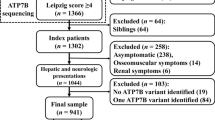Abstract
Wilson disease is a human disorder of copper metabolism resulting in toxic copper accumulation. Patients present with a high clinical variability, even when sharing identical mutations. MURR1, the gene causing canine copper toxicosis in Bedlington terriers, maps to chromosome 2 in humans, a region different to the Wilson gene locus. MURR1 might influence human copper metabolism and the clinical presentation of Wilson disease patients. This study analyzed MURR1 gene sequence in Wilson disease patients and MURR1 gene transcription in selected patients. Mutation analysis of three exons of the MURR1 gene including the intron-exon boundaries was performed in 63 Wilson disease patients by direct sequencing. Of the 63 Wilson patients 19 (30%) had basepair changes in the MURR1 gene. Three intronic base pair changes, one new sequence variation and two known polymorphisms were detected, including the GAT/GAC heterozygous state at codon Asn 164 in 15 (24%) of the analyzed patients. This suggests that GAT/GAC heterozygous state at codon Asn 164 is associated with an earlier onset of disease.


Similar content being viewed by others
Abbreviations
- PCR :
-
Polymerase chain reaction
- RT :
-
Reverse transcription
- UTR :
-
Untranslated region
- WD :
-
Wilson disease
References
Scheinberg IH, Sternlieb I (1984) Wilson’s disease. Saunders, Philadelphia
Gollan JL, Gollan TJ (1998) Wilson disease in 1998: genetic, diagnostic and therapeutic aspects. J Hepatol 28 [Suppl 1]:28–36
Schilsky ML (1996) Wilson disease: genetic basis of copper toxicity and natural history. Semin Liver Dis 16:83–95
Bowcock AM, Farrer LA, Herbet JM, Agger M, Sternlieb I, Scheinberg IH et al (1988) Eight closely linked loci place the Wilson’s disease locus within 13q14–q21. Am J Hum Genet 43:664–674
Bull PC, Thomas GR, Rommens JM, Forbes JR, Cox DW (1993) The Wilson disease gene is a putative copper transporting P-type ATPase similar to the Menkes gene. Nat Genet 5:327–337
Petrukhin K, Fischer SG, Piratsu M, Tanzi RE, Chernov I, Devoto M et al (1993) Mapping, cloning and genetic characterization of the region containing the Wilson disease gene. Nat Genet 5:338–343
Tanzi RE, Petrukhin K, Chernow I, Pellequer JL, Wasco W, Ross B et al (1993) The Wilson disease gene is a copper transporting ATPase with homology to the Menkes disease gene. Nat Genet 5:344–350
Schaefer M, Gitlin JD (1999) Genetic disorders of membrane transport. IV. Wilson’s disease and Menkes disease. Am J Physiol 276:G311–G314
Brewer GJ (1998) Wilson disease and canine copper toxicosis. Am J Clin Nutr 67 [Suppl]:1087–1090
Kenney S, Cox DW (curators) (ND) Wilson disease mutation database.http://www.uofa-medical-genetics.org/wilson/index.php
Brewer GJ (2000) Recognition, diagnosis, and management of Wilson’s disease. Proc Soc Exp Biol Med 223:39–46
Gordon RT, Forbes JR, Roberts EA, Walshe JM, Cox DW (1995) The Wilson disease gene: spectrum of mutations and their consequences. Nat Genet 9:210–217
Riordan SM, Williams R (2001) The Wilson’s disease gene and phenotypic diversity. J Hepatol 34:165–171
Schiefermeier M, Kollegger H, Madl C, Polli C, Oder W, Kuehn HJ et al (2000) The impact of apolipoprotein E genotypes on age at onset of symptoms and phenotypic expression in Wilson’s disease. Brain 123:585–590
Schaefer M, Hopkins RG, Failla ML, Gitlin JD (1999) Hepatocyte-specific localization and copper-dependent trafficking of the Wilson’s disease protein in the Liver. Am J Physiol 276:G639–G646
Hardy RM, Stevens J, Band-Stowe CM (1975) Chronic progressive hepatitis in Bedlington terriers associated with elevated liver copper concentrations. Minn Vet 15:13–24
Johnson GF, Sternlieb I, Twedt DC, Grushoff PS, Scheinberg I (1980) Inheritance of copper toxicosis in Bedlington terriers. Am J Vet Res 41:1865–1866
Owen CA Jr, Ludwig J (1982) Inherited copper toxicosis in Bedlington terriers: Wilson’ disease (hepatolenticular degeneration). Am J Pathol 106:432–434
Twedt DC, Sternlieb I, Gilbertson SR (1979) Clinical, morphological and chemical studies on copper toxicosis of Bedlington terriers. J Am Vet Med Assoc 175:269–275
Sluis BJ van de, Breen M, Nanji M, van Wolferen M, de Jong P, Binns MM et al (1999) Genetic mapping of the copper toxicosis locus in Bedlington terriers to dog chromosome 10, in a region syntenic to human chromosome region 2p13–p16. Hum Mol Genet 8:501–507
Nabetani A, Hatada I, Morisaki H, Oshimura M, Mukai T (1997) Mouse U2af1-rs1 is a neomorphic imprinted gene. Mol Cell Biol 17:789–798
Sluis B van de, Rothuizen J, Pearson PL, van Oost BA, Wijmenga C (2002) Identification of a new copper metabolism gene by positional cloning in a purebred dog population. Hum Mol Genet 11:165–173
Klomp AE, van de Sluis B, Klomp LW, Wijmenga C (2003) The ubiquitously expressed MURR1 protein is absent in canine copper toxicosis. J Hepatol 39:703–709
Mueller T, van de Sluis B, Zhernakova A, van Binsbergen E, Janecke AR, Bavdekar A et al (2003) The canine copper toxicosis gene MURR1 does not cause non-Wilsonian hepatic copper toxicosis. J Hepatol 38:164–168
Tao TY, Liu F, Klomp L, Wijmenga C, Gitlin J (2003) The copper toxicosis gene product Murr1 directly interacts with the Wilson disease protein. J Biol Chem 278:41593–41596
Hefter H, Weiss P, Wesch H, Stremmel W, Feist D, Freund HJ (1995) Late diagnosis of Wilson’s Disease in a case without onset of symptoms. Acta Neurol Scand 91:302–305
Acknowledgements
We sincerely thank the patients for their help and willingness to participate in this study. We thank Prof. Ferenci, Department of Gastroenterology and Hepatology, Vienna for WD gene analysis and Cathrin Thunert for collecting clinical data and patient specimens.
Author information
Authors and Affiliations
Corresponding author
Rights and permissions
About this article
Cite this article
Stuehler, B., Reichert, J., Stremmel, W. et al. Analysis of the human homologue of the canine copper toxicosis gene MURR1 in Wilson disease patients. J Mol Med 82, 629–634 (2004). https://doi.org/10.1007/s00109-004-0557-9
Received:
Accepted:
Published:
Issue Date:
DOI: https://doi.org/10.1007/s00109-004-0557-9




